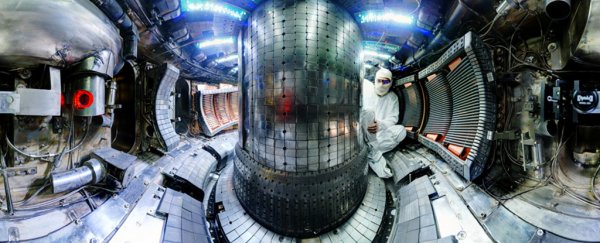Scientists have set a new world record for plasma pressure - the 'key ingredient' for producing energy from nuclear fusion - which means this clean and sustainable energy source is closer to our grasp than ever before.
The new record stands at 2.05 atmospheres - a 15 percent jump over the previous record of 1.77 atmospheres. Both this record and the last were set at the custom-built Alcator C-Mod reactor at MIT.
While a viable nuclear fusion reactor ready to power our homes is still a long way off, these increased pressures equate to increased reaction rates, and are more evidence that we're getting closer to a reactor that's technologically and economically viable.
It also gives scientists more clues about how best to move forward.
"This is a remarkable achievement that highlights the highly successful Alcator C-Mod program at MIT," said physicist Dale Meade of Princeton Plasma Physics Laboratory, who wasn't involved in the experiments.
"The record plasma pressure validates the high-magnetic-field approach as an attractive path to practical fusion energy."
To reach the 2.05-atmosphere record, MIT researchers turned the reactor up to 35 million degrees Celsius (63 million degrees Fahrenheit) - over twice as hot as the Sun's core - holding plasma producing 300 trillion fusion reactions per second for 2 seconds.
These three variables - temperature, pressure, and time sustained - act as trade-offs, as previous records from teams from around the world have demonstrated. For example, while the Alcator C-Mod reactor has the top spot in terms of pressure, other reactions have been hotter or lasted longer.
However, plasma pressure is crucial to the overall energy produced, which is why the MIT team is so excited. It says pressure levels are "two-thirds of the challenge" of producing nuclear fusion reactions.
Scientists think nuclear fusion could give us the clean, safe, and virtually unlimited energy source we've been looking for - it essentially replicates what's happening on the Sun here on Earth, by heating tiny elements of matter to over several million degrees Celsius, and forming the superheated gas called plasma.
Isolate plasma from ordinary matter using a super-strong magnetic field, and there's your energy source - one that could replace all nuclear and fossil fuel power plants at a stroke.
And unlike the nuclear fission reactions that power today's nuclear power plants (where atoms are split), nuclear fusion (where atoms are fused together) creates no radioactive waste, and there's no chance of a meltdown either.
Sounds great, right? That's why scientists around the world are working hard to meet the incredibly complex challenges of replicating a 'star in a laboratory' - something that could still take decades to achieve.
The fact is that today's machines still use more energy than they create, due to the super-high temperatures involved, but we're making progress all the time, as the MIT team has shown.
Unfortunately, it's the end of the road for the record-breaking Alcator C-Mod reactor after 23 years, with government funding being diverted to the ITER machine being constructed in France. It's hoped ITER will one day become the world's first self-sustaining nuclear fusion machine.
Other physicists are working on tweaked designs and approaches to try and find the magic formula that makes nuclear fusion self-sustaining, and when (or if) that historic moment happens, the Alcator C-Mod can be proud of the role its played.
The MIT researchers are presenting the results of their record-breaking experiments at the International Atomic Energy Agency Fusion Energy Conference this month. If you've got any questions, they'll be hosting a Reddit AMA on October 20.
